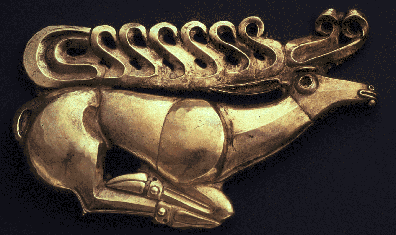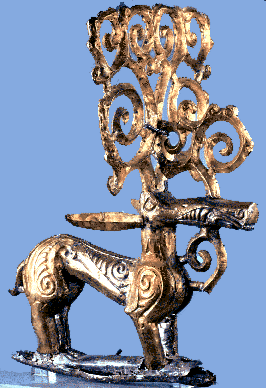|
. Curated by Joan
Aruz, acting associate curator of the Ancient Near East department, this
exhibit from the Metropolitan presents objects from several nomadic cultures
of different periods and geographic regions across Central Asia. The first
part of the exhibit is dedicated to material uncovered from the largest of
25 kurgans near the village of Filippovka, in the foothills of the southern
Ural Mountains of Russia, by a team from the Institute of History, Language,
and Literature of the Ufa Research Center of the Russian academy of Sciences.
 This rich collection of artifacts, all dating from the 4th century BC, escaped
earlier treasure-hunting, and was recovered during recent excavation of this
vast burial mound-- measuring almost 400 feet in diameter and 22 feet in
height-probably the tomb of a local chieftain. This rich collection of artifacts, all dating from the 4th century BC, escaped
earlier treasure-hunting, and was recovered during recent excavation of this
vast burial mound-- measuring almost 400 feet in diameter and 22 feet in
height-probably the tomb of a local chieftain.
Fig.1: Gold shield emblem with stag.
The first gallery of the exhibit is dedicated to the most impressive of the
26 golden deer recovered in the kurgan, those with antlers held perpendicular
to the body, each almost two feet high. Often a lone animal is shown in a
recumbent pose, perhaps in the moment of collapse before death, such as in
the gold shield emblem of a stag from the end of the 7th century BC which
marks the Metropolitan exhibit (fig.1). The five most skillfully rendered
(one of which is shown here; fig.3) were found in the passageway outside
the main burial chamber, there perhaps to wait as guardians, or to carry
the dead to the afterlife. These are, in fact, no ordinary deer, but supernatural
animals with a strange amalgamation of features, such as a goat-like beard
and tail, long, outlandish ears and tubular, flat nuzzles. Their bodies are
decorated entirely with deeply carved spirals, a motif that is emphasized
in the enormous, highly curved antlers. These, in turn, terminate in birds'
heads, in a manner we have seen on many of the Scythian artifacts, although
the overall ornamental style of these creatures resembles that of art found
much farther east, in the Altai region and in western China.
The second gallery is round in shape to evoke the burial chamber of the kurgan,
and contains additional material that would have accompanied the dead. This
includes eight other deer, found in surrounding treasure pits, somewhat less
carefully carved and covered half in gold and half in silver. The room also
contains the personal effects of the deceased; gold appliques from his clothing,
jewelry and weapons, and the ornaments that had decorated his horse's bridle.
The latter are in an Achaemenid style and may have been a gift from a Persian
chief. A large silver mirror evokes the ceremonial scene from the Scythian
diadem and may have had mythical significance, perhaps as a tool to reflect
away evil spirits.
The gold handles and mounts for up to 100 wooden bowls, as well as beautiful
gold-decorated dippers found in the treasure pits surrounding the main
chamber are the
remains of a ritual drinking ceremony, probably of the hallucinogenic hauma,
that took place just before the tomb was sealed. Many of these handles and
plaques are also in the form of griffins, stags, and other predators, and
are rendered within the intricate scrollwork which is distinctive of the
“Scytho-Siberian” animal style. A divergence from the artwork from
the Ukraine is the addition of animals such as argali (wild sheep) and camels
(fig.2), which clearly designate further eastern influence, particularly
contact with Bactria. divergence from the artwork from
the Ukraine is the addition of animals such as argali (wild sheep) and camels
(fig.2), which clearly designate further eastern influence, particularly
contact with Bactria.
Fig.2: Golden plaques with designs of camels.
Much of the remainder of the exhibit features Scythian, Sarmatian and Siberian
art from the State Hermitage in St. Petersburg. Most of the Scythian pieces
will already be familiar to those who visited the exhibit in Brooklyn. A
small globular gold vessel shows Scythian men with long, flowing hair and
beards who in some ways are close counterparts to those depicted on the golden
helmet described above, but here they are shown not actively engaged in combat,
but perhaps in scenes preparing for and repairing from battle. Another
interpretation is that the quietly evocative scenes illustrate the legend
we know from Herodutus of how Heracles’youngest son, Scythes, became
the ruler of Scythia when he was the only one able to string hisfather's
bow. Finally, it is worth observing the scene of epic drama that unfolds
on the top of a small gold comb, which was found next to the right shoulder
of a buried Scythian ruler. The actors in the scene, each rendered in the
round in minute detail, wear a combination of Greek and Scythian armor, either
as reference to a specific myth or historical event, or merely as a reflection
of the cultural infusions growing increasingly common in Scythian culture.
The exhibit at the Metropolitan also challenges us to recognize connections
between the Scythians with those cultures further east. We have seen the
various associations, both western and eastern, inherent in the burial objects
from Filippovka, which lies roughly in the center of this great steppe corridor;
now we move further to the east to view material from the Altai moutains,
where one can see increasing influence both from (Achaemenid) Iranian and
Chinese art.
Even less is known about the ancient Altai nomads than their western cousins.
Much of our information comes from the 1929 excavations of the “frozen
tombs” of
Pazyryk, which date from the fifth to the fourth centuries BC--for although
the tombs had been robbed in antiquity,the permafrost filling the tombs preserved
a wealth of less precious objects of wood, leather and textiles. Thus, in
cedar and larch we see the same familiar animal motifs-griffins and birds-but
here carved in a fantastical, flowing style. The swirls and spirals we saw
in the Filippovka stags again predominate, filling in the bodies of the tigers
and prey, for example, on the long wooden lid which covered the massive
tree-trunk sarcophagus found in kurgan 2 of Bashadar. These curvilinear motifs
are further emphasized in the leather appliques, where spiral, tear-drop
and triangular cut-outs create an openwork effect w hich is clearly echoed
in certain metal plaques of the Scythians (see, for example, Brooklyn cat.
#123). hich is clearly echoed
in certain metal plaques of the Scythians (see, for example, Brooklyn cat.
#123).
Finally, the textiles allow us to see these incredible creatures in full
color. One fragmentary felt hanging depicts a struggle between a sinuous
demon made up of human, feline, bird and stag elements and a preposterously
ornate phoenix. While the demon has counterparts in Persian art, the phoenix's
origin is probably Chinese. Once again we see the propensity of these far-ranging
nomads to appropriate the art of their neighbors, without ever totally losing
the basic elements of their own, inherent style.
Fig.3: Golden deer from tomb near Filippovka.
At some point in time that distinctive nomadic art-style became so watered-down
that it becomes difficult to distinguish. The art of the later Sarmatians,
even, seems to have little of the vitality of the classic “animal
style.” And yet it is possible to suggest that certain aspects of this
style, including a propensity to depict both actual and imaginary beasts,
lived on in the art of much later nomadic tribes called barbarians, who swept
in from the east to overrun the civilized world at the fall of the Roman
Empire.
. Michele A. Miller
This article appears in Vol.2, No.4 of Athena
Review.
.
|
|